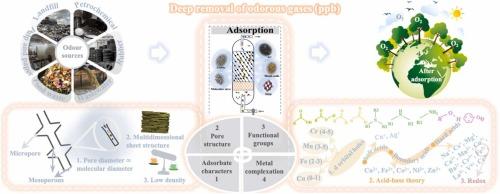A review of enhanced adsorption removal of odor contaminants with low ppm concentration levels: the key to technological breakthrough as well as challenges
IF 12.2
1区 环境科学与生态学
Q1 ENGINEERING, ENVIRONMENTAL
引用次数: 0
Abstract
The industrial production processes often produce different concentrations and types of odorous pollutants. Most odors have a low odor threshold, and the human sense of smell can still have a strong, unpleasant odor even at low ppb concentrations. The main challenges in low ppm concentration odor purification are short contact time, high air volume, low equilibrium adsorption capacity, and easy physical desorption. For the first time, this work reviews the technical paths how to purify four typical types of low concentrations of odors such as H2S, NH3, CH3SH, and CH3SCH3 from low ppm concentration levels to low ppb, with the view of the odor sources, the development of treatment technology, international permissible emission standards, and the recent status of adsorbent materials. To begin, Citespace software is employed to analyze the progress, hotspots, and technology trends in the field of odor pollutant research over the past 28 years and the factors that affect removal efficiency of low-concentration odorous pollutants are discussed in detail. Then, taking activated carbon, molecular sieve, and metal-organic frameworks as target adsorbents, how to strengthen the integrated ways of physical adsorption and chemical adsorption of these adsorbents are suggested starting from the synergistic effects of modifications for pore structure, surface chemical functional groups, and complexation and redox reactions of metal ions. As a practice, the application cases of purifying low-concentration odorous pollutants by the adsorption are briefly introduced. Finally, the challenges of developing novel adsorption materials and technologies to purify low-concentration odorous pollutants toward lower than odor threshold are presented.

低ppm浓度水平的臭味污染物强化吸附去除技术综述:技术突破的关键与挑战
工业生产过程中通常会产生不同浓度和类型的异味污染物。大多数气味的气味阈值较低,即使在低ppb浓度下,人的嗅觉仍会产生强烈的难闻气味。低ppb浓度气味净化的主要挑战是接触时间短、风量大、平衡吸附容量低、物理解吸容易。本研究首次从气味来源、处理技术的发展、国际允许排放标准、吸附剂材料的近况等方面,回顾了如何将 H2S、NH3、CH3SH、CH3SCH3 等四种典型低浓度气味从低 ppm 浓度净化到低 ppb 浓度的技术路径。首先,利用 Citespace 软件分析了 28 年来恶臭污染物研究领域的进展、热点和技术趋势,并详细讨论了影响低浓度恶臭污染物去除效率的因素。然后,以活性炭、分子筛和金属有机框架为目标吸附剂,从孔隙结构、表面化学官能团的修饰和金属离子的络合与氧化还原反应的协同效应出发,提出了如何加强这些吸附剂的物理吸附和化学吸附的综合途径。在实践中,简要介绍了通过吸附净化低浓度恶臭污染物的应用案例。最后,介绍了开发新型吸附材料和技术以净化低浓度恶臭污染物并使其低于恶臭阈值所面临的挑战。
本文章由计算机程序翻译,如有差异,请以英文原文为准。
求助全文
约1分钟内获得全文
求助全文
来源期刊

Journal of Hazardous Materials
工程技术-工程:环境
CiteScore
25.40
自引率
5.90%
发文量
3059
审稿时长
58 days
期刊介绍:
The Journal of Hazardous Materials serves as a global platform for promoting cutting-edge research in the field of Environmental Science and Engineering. Our publication features a wide range of articles, including full-length research papers, review articles, and perspectives, with the aim of enhancing our understanding of the dangers and risks associated with various materials concerning public health and the environment. It is important to note that the term "environmental contaminants" refers specifically to substances that pose hazardous effects through contamination, while excluding those that do not have such impacts on the environment or human health. Moreover, we emphasize the distinction between wastes and hazardous materials in order to provide further clarity on the scope of the journal. We have a keen interest in exploring specific compounds and microbial agents that have adverse effects on the environment.
 求助内容:
求助内容: 应助结果提醒方式:
应助结果提醒方式:


